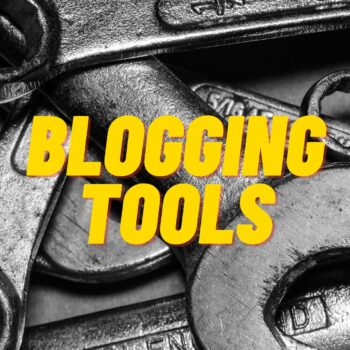Welcome, aspiring blogger! So, you’ve taken the exciting first step towards starting your own blog – that’s wonderful! But I understand that diving into the world of blogging can be overwhelming. There are countless platforms, tools, and strategies to consider, and it can be difficult to know where to even begin.
Don’t worry, you’re not alone! Many new bloggers find themselves staring at a screen full of options, wondering which tools are truly essential for getting started. That’s why I’m here to help you cut through the noise and focus on the essential blogging tools for beginners – the tools that will set you up for success from day one.
In this guide, we’ll explore the must-have tools for creating, managing, and promoting your blog effectively. These tools will streamline your workflow, help you write better content, attract more readers, and ultimately achieve your blogging goals.
Trust me, having the right tools in your blogging toolkit can make all the difference in your blogging journey. Are you ready to discover the essentials? Let’s dive in!
Must-Have Blogging Tools for Beginners: Your Foundation for Success
Let’s dive right into the heart of it: the essential blogging tools that every beginner needs to get started. These tools will form the backbone of your blogging workflow, making the process of creating, publishing, and promoting your content much smoother.
Content Management System (CMS): Your Blog’s Home
Think of a content management system (CMS) as the engine that powers your blog. It’s where you’ll write, edit, and publish your posts, manage your website’s design, and control various settings.
For beginners, two of the most popular and user-friendly CMS options are:
- WordPress.com: This hosted platform is super easy to set up and use. It offers a wide range of themes and basic customization options, making it a great choice for those who want to start blogging quickly and easily.
- Blogger: Another free, beginner-friendly platform from Google, Blogger provides a simple interface and basic tools for creating and publishing blog posts. It’s a good option if you’re looking for a no-frills blogging experience.
If you’re looking for more control and customization options, you might consider self-hosted WordPress. While it requires a bit more technical know-how, it offers unparalleled flexibility and a vast library of plugins and themes to enhance your blog.
No matter which CMS you choose, having a reliable platform to build your blog on is absolutely essential. It will be your home base, your digital storefront, and the place where your readers will come to connect with you and your content.
Let’s move on to the next set of essential tools that will help you create high-quality content…
Crafting Compelling Content: Writing & Editing Tools
Now that you have a home for your blog (your CMS), let’s talk about the tools that will help you create content that captures attention, informs, and entertains your readers. After all, great content is the heart and soul of any successful blog.
Polishing Your Prose: Grammar & Spelling Checkers
Even the most experienced writers make mistakes. That’s where grammar and spelling checkers come in. These handy tools can help you catch typos, grammatical errors, and awkward phrasing, ensuring that your writing is clear, polished, and professional.
Here are two popular options that are perfect for beginners:
- Grammarly: This powerful tool integrates with your web browser and various writing platforms, providing real-time suggestions and corrections as you write. It’s like having a personal editor on call 24/7.
- ProWritingAid: Similar to Grammarly, ProWritingAid offers comprehensive grammar and style checks, along with detailed reports to help you identify areas for improvement in your writing.
While both of these tools have free versions with basic features, their premium plans offer more advanced checks and suggestions, making them worthwhile investments as your blog grows.
Crafting Killer Headlines: Headline Analyzers
Your headline is the first impression your post makes on potential readers. It’s what entices them to click and read more. That’s why crafting compelling headlines is so important.
CoSchedule Headline Analyzer is a free tool that analyzes your headlines based on various factors, such as word balance, emotion, and length. It provides a score and suggestions for improvement, helping you write headlines that grab attention and drive clicks.
Finding Your Flow: Distraction-Free Writing Environments
For many writers, distractions are the enemy of productivity. If you find yourself constantly checking email, social media, or other websites while writing, a distraction-free writing environment can be a lifesaver.
FocusWriter is a simple, free tool that creates a minimalist writing space, blocking out all distractions and allowing you to focus solely on your words. It’s a great way to get into the zone and write more efficiently.
In the next section, we’ll explore tools that will help you visually enhance your blog posts and make them more engaging for your readers. So stay tuned!
Visual Appeal: Image Creation & Editing Tools
A picture is worth a thousand words, right? Well, in the blogging world, that couldn’t be more true. Eye-catching images are essential for grabbing attention, breaking up text, and making your posts more visually appealing. Luckily, you don’t need to be a graphic design pro to create stunning visuals for your blog.
Free Stock Photos: A Treasure Trove of Visuals
One of the easiest ways to find high-quality images for your blog is to use free stock photo sites. These websites offer a vast collection of images that you can use for free (with attribution in some cases).
Some of the most popular free stock photo sites include:
- Unsplash: Known for its beautiful, high-resolution photos covering a wide range of topics.
- Pexels: Another great source of free stock photos, with a diverse collection of images for various niches.
When choosing images, make sure they are relevant to your content and visually appealing. Remember, a well-chosen image can enhance your post and make it more shareable on social media.
Basic Image Editors: Making Your Mark
While stock photos are a great starting point, sometimes you might want to add a personal touch or create custom graphics. That’s where basic image editors come in handy.
- Canva: This user-friendly online tool makes it easy to create social media graphics, featured images for your blog posts, and even simple infographics. It offers a wide range of templates, fonts, and design elements to help you get started.
- Pixlr: If you need more advanced editing capabilities, Pixlr is a great option. It’s a free online photo editor that offers a wide range of tools for cropping, resizing, adjusting colors, and adding text and effects.
With a little creativity and these easy-to-use tools, you can create eye-catching visuals that will elevate your blog posts and make them stand out from the crowd.
Up next, we’ll explore the tools that will help you get your blog noticed by search engines and attract more organic traffic…
Getting Found: SEO Tools for Bloggers
Creating amazing content is one thing, but getting people to actually find it is a whole other ballgame. That’s where search engine optimization (SEO) comes in. SEO is the practice of optimizing your website and content to rank higher in search engine results pages (SERPs), making it easier for potential readers to discover your blog organically.
Now, I know SEO can seem like a complex beast, but don’t worry, you don’t need to be an expert to get started. There are plenty of user-friendly SEO tools out there that can help you understand and improve your blog’s visibility in search engines.
Keyword Research Tools: Uncovering Your Audience’s Language
Keywords are the words and phrases that people type into search engines when looking for information online. To attract organic traffic to your blog, it’s crucial to understand what keywords your target audience is using and incorporate them strategically into your content.
Here are two free keyword research tools that are great for beginners:
- Google Keyword Planner: This tool, available within Google Ads, allows you to research keywords related to your niche and get insights into their search volume and competition.
- AnswerThePublic: This tool provides a visual representation of the questions people are asking about a particular topic, giving you valuable insights into potential blog post ideas and long-tail keywords.
By understanding the language your audience is using, you can create content that aligns with their search intent and improves your chances of ranking higher in search results.
SEO Plugins: Your WordPress SEO Sidekick
If you’re using self-hosted WordPress for your blog (and I highly recommend it!), SEO plugins can be incredibly helpful for optimizing your content and website structure.
- Yoast SEO: This popular plugin provides real-time feedback on your content’s SEO friendliness, helping you optimize your titles, meta descriptions, and readability.
- Rank Math: Another excellent SEO plugin, Rank Math offers similar features to Yoast SEO but with a more streamlined interface and some additional functionalities like keyword tracking and schema markup.
These plugins can guide you through the technical aspects of SEO, making it easier to implement best practices and improve your blog’s visibility in search engines.
SEO: An Ongoing Journey
Remember, SEO is not a one-time task. It’s an ongoing process of optimizing your website and content to adapt to changing search engine algorithms and user behavior. By using the right tools and staying informed about SEO best practices, you can improve your blog’s ranking over time and attract a steady stream of organic traffic.
In the next section, we’ll delve into social media management tools that can help you expand your blog’s reach and connect with your audience…
Amplifying Your Reach: Social Media Management Tools
In today’s digital age, social media is a powerful tool for bloggers. It allows you to connect with your audience, share your content, and build a community around your blog. But managing multiple social media platforms can quickly become overwhelming, especially when you’re just starting out.
That’s where social media management tools come to the rescue. These tools streamline the process of scheduling posts, tracking engagement, and analyzing your social media performance, freeing up your time to focus on creating great content.
Scheduling Tools: Your Social Media Time-Saver
Consistency is key when it comes to social media. By scheduling your posts in advance, you can ensure that your content is shared regularly, even when you’re busy with other tasks.
Here are two popular scheduling tools that are perfect for beginners:
- Buffer: This intuitive tool allows you to connect your social media accounts and schedule posts across multiple platforms. It also offers analytics to track your posts’ performance.
- Hootsuite: Another versatile scheduling tool, Hootsuite allows you to manage multiple social media accounts from one dashboard. It offers features like post scheduling, content curation, and social media monitoring.
By automating your social media posting, you can save time and ensure that your content reaches your audience at the optimal times for engagement.
Mention Trackers: Staying in the Loop
It’s important to know when people are talking about your blog or brand online. Mention trackers help you monitor social media conversations and online mentions of your blog, so you can respond promptly and engage with your audience.
- Mention: This tool monitors mentions of your blog across various social media platforms and websites, alerting you in real-time so you can join the conversation.
By staying on top of mentions, you can build relationships with your readers, address any concerns, and participate in relevant discussions, further strengthening your blog’s community.
Social Media: A Powerful Amplifier
Social media is a valuable tool for promoting your blog and connecting with your audience. By utilizing social media management tools, you can streamline your social media efforts and amplify your blog’s reach.
In the next section, we’ll delve into analytics and tracking tools that will help you understand your audience, measure your blog’s performance, and make data-driven decisions to grow your blog…
Measuring Your Success: Analytics & Tracking Tools
As the saying goes, “what gets measured, gets managed.” That’s certainly true when it comes to blogging. To understand how your blog is performing, identify areas for improvement, and make informed decisions about your content strategy, you need to track and analyze your data.
Thankfully, there are powerful analytics and tracking tools available that can provide valuable insights into your blog’s traffic, audience demographics, and content performance.
Google Analytics: Your Blog’s Report Card
Think of Google Analytics as your blog’s report card. It provides a wealth of data about your website traffic, including:
- Audience Overview: Information about your visitors, such as their demographics, interests, and location.
- Acquisition: Data on how people find your blog (e.g., through search engines, social media, or direct visits).
- Behavior: Insights into how visitors interact with your content, including which pages they visit, how long they stay, and where they drop off.
By analyzing this data, you can gain valuable insights into your audience’s preferences, identify your most popular content, and discover areas where you can improve your blog’s performance.
Google Search Console: Your SEO Compass
Google Search Console is another essential tool for bloggers who want to improve their visibility in search engines. It provides data on how Google views your website, including:
- Search Performance: Information on how often your website appears in search results, which keywords people are using to find your blog, and your average click-through rate.
- Index Coverage: Reports on which pages on your website have been indexed by Google and any crawling errors that need to be fixed.
- Mobile Usability: Insights into how mobile-friendly your website is, which is crucial for SEO as more and more people are using mobile devices to browse the web.
By using Google Search Console, you can identify and fix any technical SEO issues, optimize your content for specific keywords, and track your progress in search rankings.
Data-Driven Decisions: The Key to Growth
Analytics and tracking tools are essential for making informed decisions about your blogging strategy. By analyzing your data, you can:
- Identify your most popular content: Understand what resonates with your audience and create more of it.
- Discover opportunities for improvement: Pinpoint areas where you can optimize your content or website to attract more visitors and improve engagement.
- Track your progress: Measure the impact of your efforts and make adjustments as needed.
By leveraging the power of data, you can continuously refine your blogging strategy and achieve your goals more effectively.
In the next section, we’ll wrap up with some tips for choosing the right tools and getting started on your blogging journey.
Choosing the Right Tools: Your Blogging Toolkit
Now that we’ve explored the essential tools for creating, managing, and promoting your blog, it’s time to create your own personal blogging toolkit. Remember, the best tools for you will depend on your specific needs, budget, and preferences.
Here are some tips to help you choose the right tools:
- Start Simple: Don’t overwhelm yourself with too many tools at once. Begin with the essential ones we’ve covered and gradually add more as you become comfortable with the basics.
- Prioritize Free Options: Many powerful blogging tools offer free plans or trials, which are perfect for beginners. Take advantage of these to test out different options before committing to a paid plan.
- Consider Your Budget: As your blog grows, you may want to invest in premium tools with advanced features. But when starting out, focus on free or budget-friendly options.
- Read Reviews and Compare: Before choosing a tool, read reviews from other bloggers and compare different options to find the best fit for your needs.
Remember, the goal is to find tools that empower you to create great content, connect with your audience, and achieve your blogging goals. Don’t get bogged down by the sheer number of options available. Focus on the essentials, experiment with different tools, and gradually build a toolkit that works for you.
Your Blogging Journey Begins Now
With the right tools in your arsenal, you’re well-equipped to embark on your blogging journey. Remember, blogging is a marathon, not a sprint. Be patient, persistent, and passionate about your topic, and you’ll see success over time.
So, what are you waiting for? Start creating content, connect with other bloggers, and share your unique voice with the world. Your blog has the potential to inspire, inform, and entertain countless readers. And remember, I’m always here to support you on your blogging journey.
Do you have any questions about the tools we covered? What are your favorite blogging tools? Share your thoughts and experiences in the comments below!
I hope this guide has been helpful for you as you embark on your blogging adventure. Happy blogging!






No Comments
Leave a comment Cancel